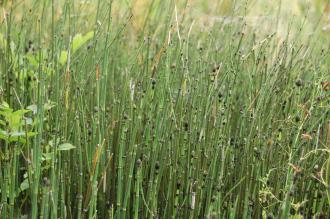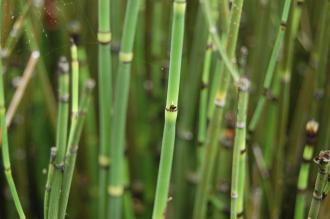
Equisetum hyemale (28/07/2014, Conservatoire botanique national de Brest, France)
Position: Full sun to partial shade
Flowering period: N/A
Soil: Consistently moist
Eventual Height: 90cm
Eventual Spread: 50cm
Hardiness: 3a, 3b, 4a, 4b, 5a, 5b, 6a, 6b, 7a, 7b, 8a, 8b, 9a, 9b
Family: Equisetaceae
Equisetum hyemale is an evergreen/ deciduous (depending on minimum temperature) herbaceous perennial with an upright habit. Its very small very dark green leaves are joined together around the stem at each joint. Its reed like stems are dark green, circular in cross section, hollow and up to 8mm across. Equisetum hyemale produces spores and does not produce flowers or seeds. Its roots may achieve a depth of up to 1m and produce runners which enables its spread.

Equisetum hyemale Stem (28/07/2014, Conservatoire botanique national de Brest, France)
Equisetum hyemale, commonly known as Rough Horsetail, Scouring Rush, Scouring Rush Horestail and Snake Grass, is native to North America, Europe (including the UK) and northern Asia. In its native habitat it grows in wetlands, river banks moist forests and woodland openings.
The etymological root of the binomial name Equisetum is from the Latin equus meaning ‘horse’ and seta meaning ‘bristle’. Hyemale is derived from the Latin meaning ‘pertaining to winter’.
The landscape architect may find Equisetum hyemale useful as a native plant suitable for planting at the edge of water bodies. It may also be used as a rain garden plant. Care should be taken when using this plant due to its invasive nature. Root barriers or containers may be used to prevent its uncontrolled spread.
Ecologically, Equisetum hyemale may provide cover for some birds and mammals.

Equisetum hyemale Spore Bud (28/07/2014, Conservatoire botanique national de Brest, France)
Equisetum hyemale prefers consistently moist, fertile, well-drained, sandy/ gravely soils. It tolerates most pH of soil. It dislikes dry soils. It will tolerate seasonal flooding. It will tolerate a planting in water to a depth of 10cm.
Equisetum hyemale requires little maintenance. It may be necessary on a periodic basis to remove the excessive spread of this plant.

